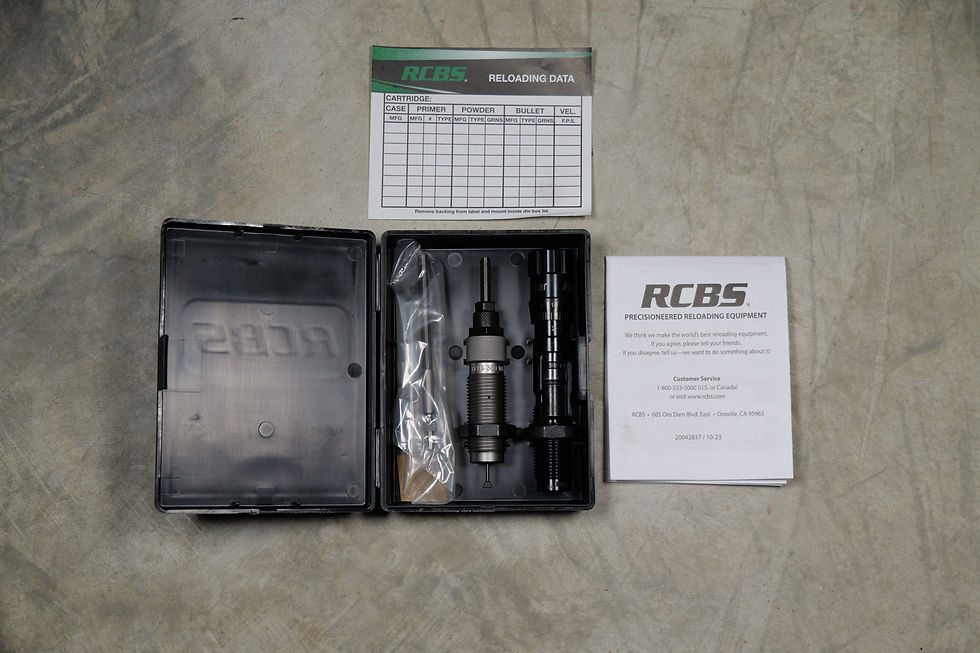Does lubricant or water increase pressure on handloads?
- Reloading_allday

- Mar 16, 2022
- 6 min read
Updated: Jul 3, 2025

One of the most commonly asked questions and theories around hand-loaded ammunition is if leaving lubricant or getting water on cases increases pressure.
The reason this speculation or theory has taken off is that commonly many individuals will shoot in geographical locations where it rains very often causing brass to get wet. Further, while shooting, they will look at case heads and notice "pressure signs" by observing flattened primers, "bolt swipe" and more.
However, this also happens with lubricant. If resizing and not cleaning the lubricant off afterward, or using excessive lubricant inside of your firearm to where it will coat the brass body, you will see the same effect by looking at the case head where it will show "signs of pressure."
While there are many theories talking about looking at the case head for different signs of pressure, we want to walk you through what is really happening.
So, while I was talking with a few reloaders, a common theme was putting water on the cases to simulate what would happen in their geographical location if rain were to get on their cases. I started to think, well, it does certainly look like pressure is present on the back of the case heads when you look at them....but, is that really showing signs of pressure? Or is it something else?
So, I called my mentor and friend, whom I also work with at Shooters World Powders, Ken Johnson. Knowing Ken as one of the best ballisticians on the planet, I started to explain to him my speculation of water or lubricant on cases knowing my question would be put to rest. Before I could finish, he knew exactly what I was talking about.
Ken explained that when a case is coated with a lubricant or is wet, it creates a layer boundary between the case wall and the chamber wall. As a result, when fired, the case has nowhere to effectively expand except backward toward the bolt. Therefore, this puts all of the force of expansion back toward the bolt and flattens primers. This is commonly known as "bolt-load." While this certainly shows signs of pressure, this does not mean that pressure has spiked. Therefore, this is another case of "false signs of pressure." Here is a diagram below of where force is normally applied to a case when fired versus when it has a boundary layer like lubricant or water.


While we are both against proponents of talking about what may be happening, we wanted to physically prove that this is occurring. As a result, we conducted a test consisting of cases being coated in water and lubricant to show that while more force is being applied to the bolt, or "bolt-load", pressure does not spike.

To begin the test, we used water and lanolin to coat the projectiles one by one before shooting them in our lab. Once we did, the following photos show the results of our independent testing. Please pay close attention to the highlighted area in the photos, which is average Peak Pressure.



As we can observe, Peak Pressure had not spiked. But, what do the case heads look like?

As you can see, here are the cases from the test of using a lubricant layer and water above. The primers are cratered and flattened. Pressure was not the direct result. In other words, the pressure generated did not flatten or crater the primers. Therefore, this is a false sign of pressure. The force was being applied backward toward the bolt, which directly resulted in the case appearing to have pressure. The simulation we just conducted is known as "bolt-load." Again, this is a false sign of pressure and is not an actual byproduct of pressure rising in itself.
While our testing is great, I also wanted to search for supplemental material showing our results were correct. As a result, I came across a research study conducted in 2019 with the same results. As you will see in the picture below, our findings directly align with what was found. However, besides water, they used an ice layer. Regardless, the peak pressure is not spiking while peak force has increased exponentially.

As we can see from the research study above, the third column is listed as Peak Pressure. Next, we can observe the fifth column listed as Peak Force.
If you take a look, peak pressure does not change drastically as peak force does. We can see that when adding an ice layer or lubricant layer to the brass, peak force increases. But, peak pressure does not. This, in itself, shows that leaving lubricant or an ice layer on the case will show false signs of pressure. However, this does not mean that it is in fact a sign of pressure.
There are some interesting results in regard to 9mm, case geometry, and length barrels that I'll leave you to read in the research study linked in this article. Moreover, almost every cartridge, wet, lubbed, or ice layered, ultimately do not show increased signs of pressure accurately, but rather false signs of pressure. It is simply increased force, or "bolt-load."
Regardless, one thing to keep in mind if you run into this problem by effectively shooting in the rain a lot, for instance, is to drop the powder charge to decrease the amount of force the case may have currently in your setup. However, when you do this, depending upon the circumstances of the load itself, when you drop the powder charge for an “easy fix”, this effectively lowers the amount of propellant that is burning. Therefore, next range outing, you can be constantly chasing your tail wondering why your load fell apart. Propellant requires pressure in order to burn. At the end of the day, keep those cases dry and chamber as much as possible.
So, I can say that we can reasonably put this to rest. Water, lubricants, and ice should be removed from cases before firing. Otherwise, false signs of pressure can show up leading you, as the handloader, to believe that you are shooting an overpressure load. It is recommended to make sure that any copious amount of lubricant applied inside of the chamber is removed because of the boundary layer being created between the case wall and chamber wall leading to false signs of pressure.
Thank you for reading! If you are interested in learning how to reload or are an experienced handloader looking to learn how internal ballistics works to significantly cut down on load development time you can find our classes here

Disclaimer: The content you are about to read is for demonstration purposes only. This includes videos, blog posts, articles, and all information associated with this website. Do not attempt anything you see on this website. Again, these are for demonstration purposes only. If you see reloading data and or comments, please refer to the manufacturer of your choice and contact a technician. We are not responsible for any false data or comments from individuals. Again, this is a demonstration for reloading. Please contact or take classes from certified reloading instructors or contact the manufacturer of your choice. Please, do not attempt to tamper or modify with ammunition or firearms. Seek out a licensed professional or gunsmith. Any information you watch or read on this website must be assumed to have an error and should not be performed. Reloadingallday will not and cannot be held responsible for harm caused to readers and watchers. The material that is covered is for demonstration purposes only. Please be aware that hand-loading and other topics covered are very dangerous and you are within full responsibility and liability for your actions. Reloadingallday is also not responsible or liable for any damage that might be caused due to those who enter this website and read any of our material or watch. Again, this is for demonstration purposes only. By reading this article, you are agreeing that you are responsible for yourself, everyone around you, watchers, viewers, commentators, and fans. You are also agreeing that you are responsible for the safety and property as follows: yourself, everyone around you, watchers, viewers, commentators, and fans. Also, you are accepting that you agree with everything this disclaimer has written down.
Keep in mind that we may receive commissions when you click our links and make purchases. However, this does not impact our reviews and comparisons. We try our best to keep things fair and balanced, in order to help you make the best choice for you.




Comments